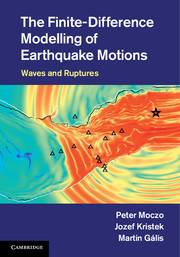Book contents
- The Finite-Difference Modelling of Earthquake Motions
- Dedication
- The Finite-Difference Modelling of Earthquake Motions
- Copyright page
- Dedication
- Contents
- Acknowledgements
- Selected symbols
- 1 Introduction
- Part I Mathematical-physical model
- 2 Basic mathematical-physical model
- 3 Rheological models of a continuum
- 4 Earthquake source
- Part II The finite-difference method
- Part III Finite-element method and hybrid finite-difference–finite-element method
- Part IV Finite-difference modelling of seismic motion at real sites
- Appendix A Time–frequency misfit and goodness-of-fit criteria for quantitative comparison of time signals
- References
- Index
3 - Rheological models of a continuum
from Part I - Mathematical-physical model
Published online by Cambridge University Press: 05 May 2014
- The Finite-Difference Modelling of Earthquake Motions
- Dedication
- The Finite-Difference Modelling of Earthquake Motions
- Copyright page
- Dedication
- Contents
- Acknowledgements
- Selected symbols
- 1 Introduction
- Part I Mathematical-physical model
- 2 Basic mathematical-physical model
- 3 Rheological models of a continuum
- 4 Earthquake source
- Part II The finite-difference method
- Part III Finite-element method and hybrid finite-difference–finite-element method
- Part IV Finite-difference modelling of seismic motion at real sites
- Appendix A Time–frequency misfit and goodness-of-fit criteria for quantitative comparison of time signals
- References
- Index
- Type
- Chapter
- Information
- The Finite-Difference Modelling of Earthquake MotionsWaves and Ruptures, pp. 18 - 57Publisher: Cambridge University PressPrint publication year: 2014

